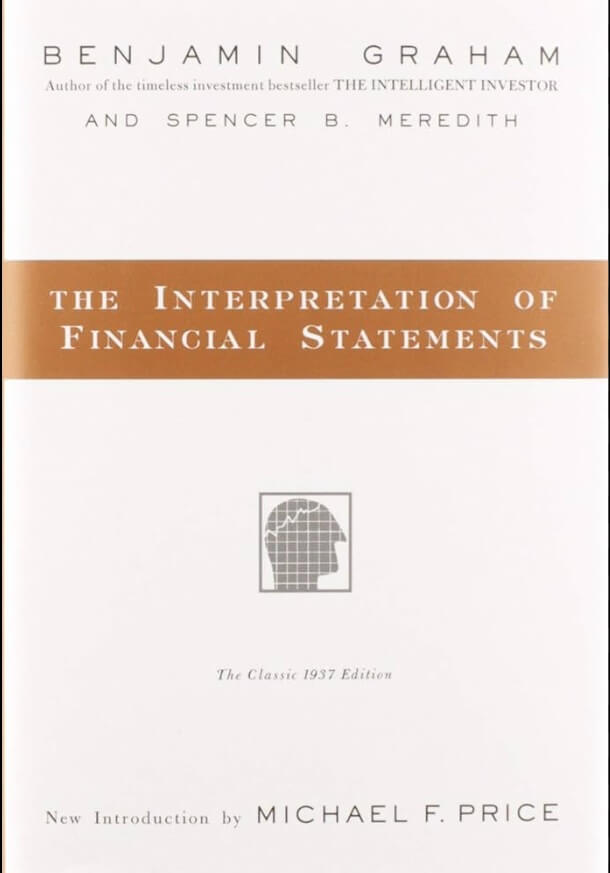Do you glaze over when looking at a balance sheet? Feel like financial statements are written in a secret code? Wonder how professional investors “see” value in a company’s numbers? If so, The Interpretation of Financial Statements is your decoder ring.
Written in 1937 by Benjamin Graham — the godfather of value investing — and Spencer B. Meredith, this slim volume demystifies the language of business. It teaches readers how to read and understand financial statements like an investor, not an accountant. And while the book is short, its lessons are mighty.
💡 Why This Book Still Matters
In an age of flashy stock tips and algorithmic trading, Graham’s little guide offers a powerful counterpoint: understand the numbers, and you’ll understand the business. While newer resources may be glossier or longer, few match this book’s clarity, conciseness, and timeless wisdom.
This book isn’t about complex valuation models or predictive analytics. It’s about financial literacy — and it delivers that in spades.
🧠 What’s Inside the Numbers?
Graham argues that every financial statement tells a story. But like any story, you need to know how to read between the lines. In just under 100 pages, the book gives readers the tools to do exactly that.
Here are the three main characters in this financial story:
⦁ The Balance Sheet – A snapshot of what a company owns and owes. It reveals liquidity, financial stability, and capital structure.
⦁ The Income Statement – Shows what a company earns. It’s about revenue, expenses, and how efficiently management turns sales into profit.
⦁ The Statement of Cash Flows – Not covered in detail in the 1937 edition (it wasn’t a standard practice then), but modern readers know this statement shows where the money is really going.
Key Concepts from the Book:
⦁ Current Assets vs. Current Liabilities: Graham emphasizes the importance of short-term financial health. If liabilities exceed assets, that’s a red flag.
⦁ Earnings Power: Don’t just look at profits — ask whether they’re consistent and sustainable.
⦁ Book Value: A company’s net worth (assets minus liabilities). It’s a baseline for determining whether a stock is overpriced or underpriced.
⦁ Fixed Charges: Costs like interest payments that must be paid no matter what. High fixed charges = high risk.
📚 Structure of the Book
Unlike Graham’s more academic tomes like Security Analysis, this book reads like a hands-on manual. Think of it as a pocket guide for new investors, business students, or anyone who wants to get serious about understanding company performance.
Part 1: The Balance Sheet
Graham walks through each line item — from cash and inventories to goodwill and preferred stock — explaining what it means, why it matters, and how to interpret it.
He stresses:
⦁ Liquidity (Can the company pay its bills?)
⦁ Asset quality (Are inventories or receivables inflated?)
⦁ Capital structure (How much debt vs. equity?)
Part 2: The Income Statement
Here, Graham shifts focus to operations. He teaches readers to look at trends in revenue, consistency in earnings, and the ratio of costs to sales.
He warns against:
⦁ One-time gains that inflate earnings
⦁ Overstated revenue with high receivables
⦁ Thin profit margins in competitive industries
Part 3: Ratios and Interpretation
Graham doesn’t drown the reader in formulas, but he introduces basic ratios that reveal a lot:
⦁ Current ratio (Current Assets / Current Liabilities)
⦁ Debt-to-equity ratio
⦁ Earnings per share (EPS)
His goal isn’t to give you rules — it’s to train your eye. Once you understand the relationships, you’ll start spotting strengths and weaknesses naturally.
✅ Why You Should Read This Book
It’s the Perfect Starting Point
Never read a balance sheet before? This is your on-ramp. Graham explains financial statements in plain English without dumbing them down. It’s clear, approachable, and packed with insight.
It Builds Investing Intuition
Rather than teaching “tricks,” Graham helps you develop judgment. Over time, you start seeing risk, financial health, and profitability — just by glancing at a company’s numbers.
It’s Still Surprisingly Relevant
Accounting standards have evolved, but the fundamentals haven’t changed. A balance sheet still shows assets and liabilities. Income statements still reveal performance. If you master the logic in this book, you’ll be ahead of most amateur investors.
🎯 Real-World Relevance
Whether you’re investing, running a business, or just trying to understand a company before you apply for a job — financial statements are the language of commerce. This book teaches you to speak it fluently.
Some modern scenarios where Graham’s principles shine:
⦁ Startup Financials: Spot overhyped companies with weak balance sheets.
⦁ Dividend Stocks: Evaluate whether a company can really afford its payout.
⦁ Retail Bankruptcies: Learn to read warning signs in declining asset quality or rising debt loads.
⦁ “Growth” Stocks: Look past the PR — what do the numbers say?
⚠️ Where the Book May Be Challenging
It’s Old-School
Some accounting terms and classifications have changed since 1937. For instance, concepts like EBITDA or cash flow statements aren’t covered. But the foundation is still rock solid — and easily updated with a bit of context.
It’s Short and Focused
This isn’t a complete investing book. It won’t teach you how to value a company or build a portfolio. It’s about understanding numbers — not predicting the future.
No Gloss, All Grit
There are no graphics, no case studies, and no stories. If you prefer a narrative-driven book (like Animal Spirits), this one will feel dry. But for those who want meat, it delivers.
💬 What Readers and Critics Say
“A hidden gem” — Many readers consider it an underrated classic that complements The Intelligent Investor.
“Timeless and clear” — Despite its age, the language remains strikingly accessible.
“The best book to read before you invest” — Often recommended to beginners who want a no-nonsense primer before tackling more complex finance texts.
📈 Final Verdict: ★★★★☆ (4/5)
The Interpretation of Financial Statements is a compact, powerful guide that teaches readers how to read and analyze a company’s financial health. It’s not flashy. It’s not exhaustive. But it’s indispensable.
For anyone who wants to move beyond financial headlines and start thinking like a real investor — this is where you start. Graham doesn’t give you tips. He gives you vision. And that’s worth far more than any stock pick.




